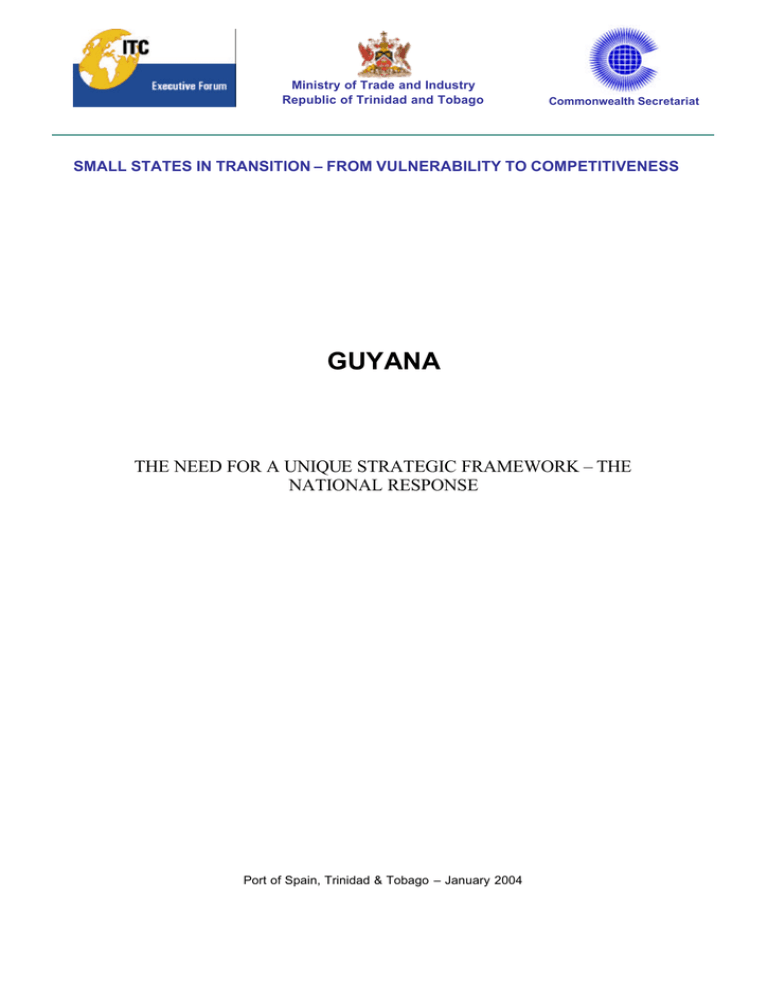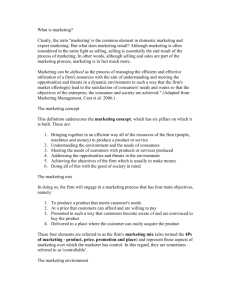GUYANA THE NEED FOR A UNIQUE STRATEGIC FRAMEWORK – THE NATIONAL RESPONSE
advertisement

Ministry of Trade and Industry Republic of Trinidad and Tobago Commonwealth Secretariat SMALL STATES IN TRANSITION – FROM VULNERABILITY TO COMPETITIVENESS GUYANA THE NEED FOR A UNIQUE STRATEGIC FRAMEWORK – THE NATIONAL RESPONSE Port of Spain, Trinidad & Tobago – January 2004 Guyana’s Export Strategy: A Long –Term Approach based on Persistence, Commitment and Patience and Realistic Expectations THE FOCUS FOR A JOINT EFFECTIVE EXPORT AND INVESTMENT STRATEGY SHOULD BE TO CHANGE THE WAY OF THINKING AND FEELING ABOUT THE CREATION AND DISTRIBUTION OF WEALTH in a market economy. THE END GOAL IS TO CREATE BETTER PAYING JOBS FOR ALL GUYANESE. WE NEED TO HIGHLIGHT THE ESSENTIAL NEED TO CHANGE ATTITUDES FOR THE SUCCESSFUL PROMOTION OF COMPETITIVENESS. A NEW BUSINESS CULTURE HAS TO BE CREATED THAT IS BASED ON THE FOLLOWING: • A COMPETITIVE AND INNOVATIVE BUSINESS-OPERATING ENVIRONMENT one of the major challenges is how to find the appropriate balance between cooperation on the one hand, and competition, on the other, within a country’s private sector AND within the global economy; take advantage of the benefits that accrue to membership in regional trading blocs and multilateral agreements such as CARICOM, WTO, the FTAA, COTONOU, CARIBAN and CBI – public and private sector officials have been sensitized about the implications of the WTO and opportunities for development; before trust between the private and public sectors can be enhanced, trust has to be developed within the private sector and within the public sector; the approach should be optimistic, problem solving, imaginative and creative; businesses must continuously adapt, compromise and moderate their business plans to maintain and achieve success; support must be provided to new AND aspiring entrepreneurs as well as to exportoriented non-governmental organizations; a nation’s prosperity is not based primarily on natural endowments, but on its ability to create a competitive and innovative business environment; after reviewing the successes of a number of small states in different parts of the world (Singapore, Barbados and Costa Rica), it is clear that smallness is not necessarily a disadvantage; winners in the new global market will have to offer the best quality, lowest price, fastest delivery and the greatest flexibility; 1 comparative advantage is shifting from natural resources to human resources and this new situation offers great opportunities for small states if they PRIORITIZE and substantially invest and upgrade in their human capital; ensure that basic labor and environmental policies, at the macro and micro levels, comply with international standards . • CONTINUOUS LEARNING about consumers, costs and competitors; substantial upgrading of human resources • THE STIMULATION OF RELATED AND SUPPORTING INDUSTRIES strengthen linkage between export promotion and import penetration to improve shortterm export efficiency; channel exporters’ demand for inputs towards domestically produced intermediates; enhance cooperation by developing the export value chain, nationally AND REGIONALLY to empower the exporter to produce, market and deliver competitive products – a program will be implemented in 2004 to increase the competitiveness of selected industry clusters . • THE PROMOTION OF AN INTEGRATED EXPORT AND INVESTMENT STRATEGY the major two constraints are that Guyana lacks significant economic diversification and significant foreign direct investment; trade brings investment and investment creates new export opportunities; in 2004, a new Investment Act will be implemented what is required is a mixed strategy with different degrees of emphasis, at one time or another, on an inward and outward orientation for each particular sector; for particular sectors , we have to implement import substituting industrialization AND export promoting industrialization for other sectors; strengthen the linkage between export diversification and specialization to build long-term export effectiveness – avoid extreme specialization by exporting a narrow range of products OR extreme diversification by exporting a little of many products; 2 a good ‘best practice’ is Malaysia that diversified away from manufacturing based on primary products to specialization in electrical products and then to a new diversification focused on manufacturing machinery; to mainstream export promotion into infrastructure and social policies. • THE CONTINUOUS ENHANCEMENT OF KEY PUBLIC SECTOR AGENCIES A Public Sector Modernization program is underway; the Ministry of Foreign Trade and International Cooperation, with assistance from USAID, has devised a trade strategy to advance the country’s development in the context of increasing globalization; a first-stop agency that is customer-driven, knowledge-based and career-enhancing with work plans based on realistic performance indicators and timelines and regular evaluation; enhance communication skills ; training, locally and externally, in project and client management AND best practices in investment promotion and investment aftercare; facilitating and supporting the creation of sectoral/export associations; initially, build an informal export support network that fully involves the private and public sectors and that focuses on the needs of the export community and then the institutionalization of the network; work with other agencies (such as the agricultural marketing corporation and research institute) to provide these specialized services – commercial intelligence, export counseling and referral to other members of the network. TO BUILD A SUSTAINABLE ECONOMY, A COUNTRY HAS TO FOCUS ON THE SIMULTANEOUS AND BALANCED PROMOTION OF: • CONSISTENT AND EFFECTIVE MACRO-ECONOMIC POLICIES low inflation, a competitive exchange rate, competitive interest rates and low fiscal deficit AND CONSISTENT AND EFFECTIVE MICRO-ECONOMIC POLICIES knowledge of markets, the costs of products and the plans of competitors; 3 cooperation between firms; training and financing; inward or outward orientation for particular industries; a public -private relationship based on open communication and a lack of defensiveness. • FOREIGN AND LOCAL INVESTMENT including joint ventures and alliances ; creating a database of potential local and foreign investors with profiles of their companies and personnel; develop research on Who is investing Where and Who are the main competitors for FDI • THE DIVERSIFICATION AWAY FROM PRIMARY PRODUCTION TO VALUE-ADDED, BRANDED PRODUCTS IN THE “TRADITIONAL AND NON-TRADITIONAL” SECTORS the prioritization of sectors with profiles – processed foods; tourism; wood products; fresh foods; services; information and communications technology; and light manufacturing. inward orientation (BORDER-IN) for particular industries (to be jointly facilitated by the private and public sectors) – FOR FIRST-TIME, FAILED AND NON-EXPORTERS build awareness of export opportunities based on ‘best practice’ motivation, market research and consulting – business advisory services by Canadian volunteers; improve productivity – programs to improve the competitiveness of the poultry, seafood, rice, tourism, garment, telecommunications, construction and jewellery industries, as well as, small fresh and processed food companies; refine tax and investment policies at the sectoral and firm levels; development of new levels of product quality and new product lines; develop capacity (using local and external sources) to do economic analysis of key sectors with export potential; 4 training to enhance production capacity, by introducing new methods and technologies, to ensure a regular supply of products and through the creation of parks for businesses in the agro-industrial and information technology sectors; supporting companies to meet ISO and HACCP standards; training on marketing and financing to upgrade business skills and for the creation of new companies – including private development banks; development of entrepreneurial skills, including cottage industries - EMPRETEC; effective coordination between public sector agencies to enhance information and upgrade skills to speed up the processing of applications, permits and licences, especially for the conversion of land from leasehold to freehold; development of information technology skills; organize projects to improve physical infrastructure – the Air Transport sector; facilitate regional development plans across the country – a 12.5 million Euros program for the depressed bauxite mining community of Linden; a joint public relations campaign to overcome any negative attitudes among the general public towards the private sector AND among the private sector towards foreign investors; deepen the understanding among local communities about the benefits of exports [trade is more important to Guyana than to almost all other countries in the world – it is exceptional for its high level of dependence upon the external sector]. • THE DIVERSIFATION OF MARKETS INCLUDING THE MAINTENANCE AND EXPANSION OF MARKET SHARE IN CURRENT MARKETS AND THE DEVELOPMENT OF NEW MARKETS outward orientation (BORDER-OUT) for particular industries (to be jointly facilitated by the private and public sectors) – FOR CONTINUING AND EXPANDING EXPORTERS market research to identify key products and sectors with significant export potential in key markets – 12 market studies done; reducing international transaction costs must be A PRIORITY – ESPECIALLY SHIPPING; develop the formal and informal relations with the country’s diplomatic missions and the Diaspora; organize inward and outward trade and investment missions and sales office establishment especially to foster south-south trade; 5 develop export free zones; sign bilateral trade treaties for specific products; matchmaking between local exporters and foreign importers ; focus especially on the small higher-earning segments of the global market that fit with the production capabilities of companies in small states “THE EL DORADO FACTOR”. • FACILITATE THE ESTABLISHMENT AND GROWTH OF MICRO, SMALL, MEDIUM AND LARGE COMPANIES for businesses that are ‘starting up’ AND ‘growing’; a Stock Exchange has been established and a Procurement Bill has been passed by Parliament; institutional strengthening of the Guyana Manufacturers Association and the Institute for Private Enterprise Development (micro-credit institution) to improve delivery of services to its members. • SUPPORT ECONOMIC ACTIVITIES IN ALL REGIONS OF A COUNTRY dispersion of export capacity 6




